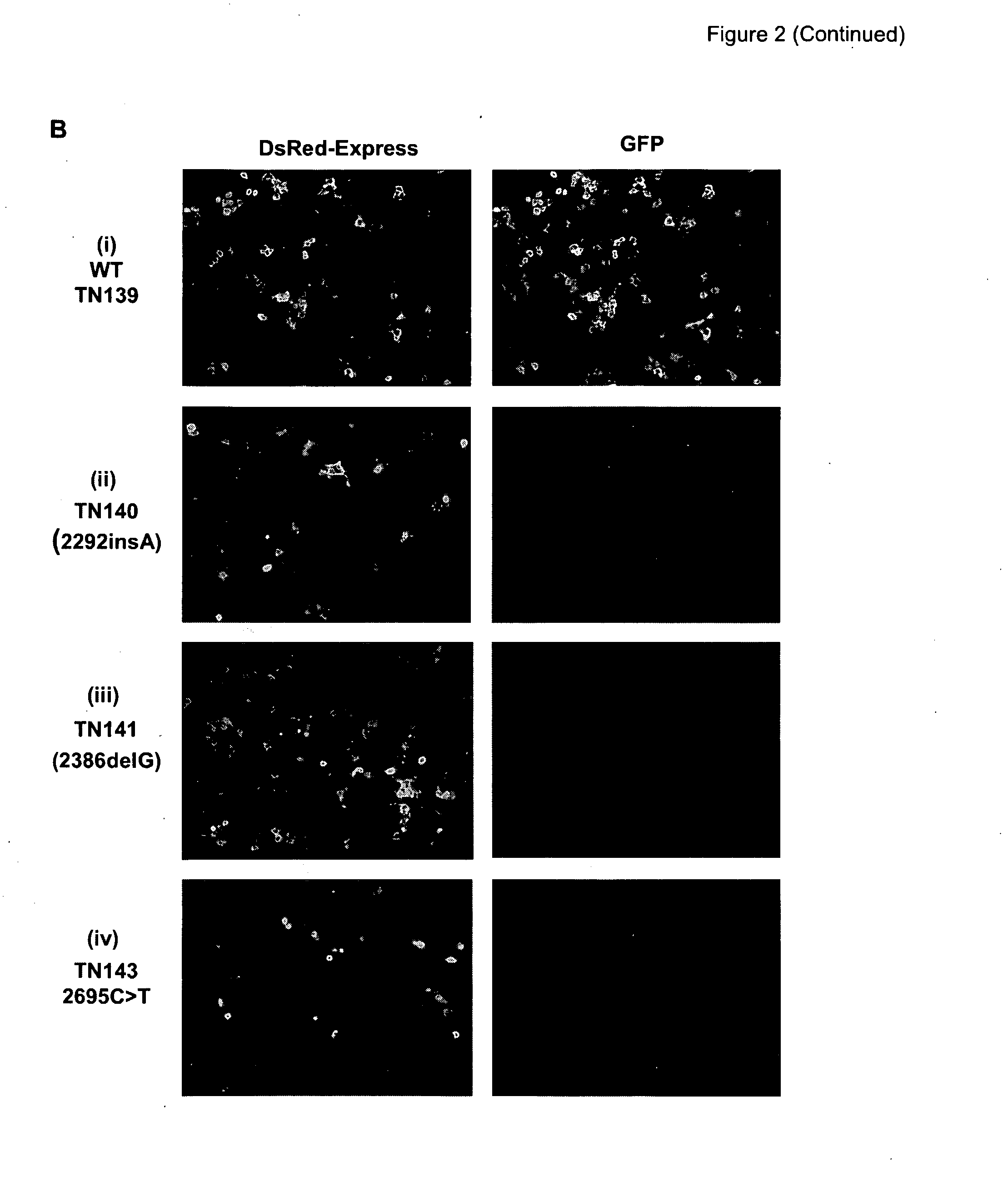Method
a technology of method and functional annotation, applied in the field of methods, can solve the problems of lack of rapid definitive testing, lack of high-throughput screening, and requirement for functional annotation, and achieve the effect of rapid investigation and potential utility of screening agents
- Summary
- Abstract
- Description
- Claims
- Application Information
AI Technical Summary
Benefits of technology
Problems solved by technology
Method used
Image
Examples
example 1
Materials and Methods
[0287]Single-cell based dual-fluorescence splicing assay constructs were generated by replacing exon 9 of plasmid pTN136 with exon 12 of BMPR2 gene using PCR mutagenesis (14). The resultant splicing unit was cloned into Xho I and Bam HI sites of DsRed Express-GFP vector (Siskoglu and Nasim, unpublished data) and designated as pTN139. Further plasmids pTN140, pTN141, pTN142 and pTN143 bearing mutations in exon 12 at position c.2292insA, c.2386delG, c.2620G>T and c.2695C>T, respectively were generated. A double intron splicing unit was constructed by fusing an additional splicing unit of HC9 (15) at the 3′end of the Ad-Exon 12 unit of pTN136. The splicing unit of HC9 comprises the last 17 nucleotides of the non-muscle exon (NM) of human TPM3 gene together with the following 80-nucleotide intron, which was joined to a fragment of human dystrophin gene containing the last 260 nucleotides of intron 11 followed by the 100 nucleotides of exon 12. The double-intron spli...
example 2
Results
[0290]A single-cell based dual-fluorescence assay system for the functional characterization of PAH causing BMPR2 sequence variation
[0291]GENSCAN (18) (http: / / genes.mit.edu / GENSCAN.html), an algorithm simulates gene prediction based on multiple parameters, including nucleotide composition, transcription, splicing and translation signals. The program predicts that the insertion (c.2292insA), deletion (c.2386delG) and nonsense mutations (c.2695C>T) into the exon 12 of BMPR2 each may alter the strength of 5′ and 3′splice sites, exon score probability, T-score and the length of the exon (FIG. 1A) probably by activating cryptic splice sites (FIG. 1B). If correct this would lead to the skipping of the nonsense codon and hence maintain a reading frame (FIG. 1C). So as to investigate the consequence of these mutations we developed a dual-fluorescence-based assay system. Exon 12 is introduced into the construct in a manner such that successful splicing would lead to the production of ...
example 3
Mutations Containing PTCs are Subject to Nonsense-Mediated RNA Decay
[0293]As the data indicated that the presence of the nonsense mutation did not stimulate aberrant splicing, we next wished to investigate whether nonsense bearing mutations of BMPR2 triggered NMD. To study this, double intron splicing unit containing either c.2386delG or c.2292insA was introduced at the 3′end of the β-galactosidase gene in such a way that the incorporation of the PTC would lead to the truncation of a full-length protein (FIG. 4A). Thus, if the mRNA is subjected to NMD, inhibition of translation using cycloheximide or puromycin would lead to the increased level of PTC bearing mRNA and therefore the level of the truncated protein would also be increased. Following transfection significant increase in the reporter protein was observed after treating with cycloheximide (5 fold) and puromycin (20 fold) (FIG. 4B). Further confirmation that these mutations were subject to NMD, plasmids encoding siRNA that ...
PUM
| Property | Measurement | Unit |
|---|---|---|
| Volume | aaaaa | aaaaa |
| Length | aaaaa | aaaaa |
| Length | aaaaa | aaaaa |
Abstract
Description
Claims
Application Information
 Login to View More
Login to View More - R&D
- Intellectual Property
- Life Sciences
- Materials
- Tech Scout
- Unparalleled Data Quality
- Higher Quality Content
- 60% Fewer Hallucinations
Browse by: Latest US Patents, China's latest patents, Technical Efficacy Thesaurus, Application Domain, Technology Topic, Popular Technical Reports.
© 2025 PatSnap. All rights reserved.Legal|Privacy policy|Modern Slavery Act Transparency Statement|Sitemap|About US| Contact US: help@patsnap.com



